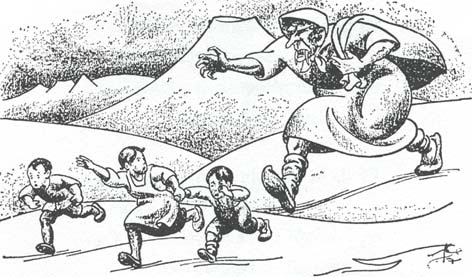Lloyd I. Sederer, M.D.

At breakfast, Guðrún (pronounced Gudrun), our friendly host at a rural guesthouse set amidst the forbiddingly beautiful lava fashioned landscape of Iceland, was telling me about the myths that pervade their 13 days of Christmas. Myths as ancient as they are timeless, the one that struck me was of Grýla. Wretchedly ugly, once a year for those fearful 13 days she leaves her mountain lair in search of children to eat. Grýla is also on her third husband, having eaten the other two when children were in short supply because they had been good. Her husbands have been huge nasty trolls, rivaling her unsavoriness.
Guðrún, in her late 20s with Nordic blue eyes and wearing a woolen sweater distinctive of the region, was a child reborn as she described, full of dread, how she would stay up nights in the part of her parents' home furthest from the craggy mountain that rose behind it, ever vigilant for Grýla's unexpected arrival. She always wore a pair of new socks, reportedly a helpful but not certain deterrent against the ogre.
As if Grýla's aversiveness were not enough, she has a massive, feral cat as ravenous and mean as she is, so the story goes. The cat's prey is not mice, but also children who don't accede to the proper rituals of family and holiday. Grýla also has 13 sons, all are offspring of her mating with her third husband, a sweetheart himself renowned for being a foul-mouthed slob and layabout. Their sons appear to have developed some redeeming qualities (such as combing wool, collecting potatoes and milking cows), but don't be fooled, since they are thieves to the bone, rascals who pilfer what they can. The Yule Lads, as they are called, cover the vast hinterland of Iceland, instead of Santa and his reindeer, to fill children's shoes left on the windowsill -- but are as apt to leave a potato as a present if a child does not gain merit in the eyes of the Christmas judges, whoever they may be.
How do families impart codes of conduct to their next generation, on remote Iceland as well as in America, Europe and throughout a diverse world? Why do terror and violence play such a prominent role?
We know that terror can disrupt the circuitry of our central nervous system and derange hormonal patterns leaving us more vulnerable to stress related diseases and habit disorders (like smoking, and eating and drinking too much). We know, too, that violence (and its threat) begets violence, in generations to come. Guðrún could still readily rouse the specter of Grýla, and her brood, and likely imparted the dread to children in her family, not just to this traveler (as did other Icelandic grownups I met who loved to tell me the tale). But our kind host did not herself become a threat, a danger to children and strangers.
Some say that fear makes for fiber, for the strength to endure the dangers and defeats that lay along life's path. Fear too helps to shape the boundaries of proper behavior. There are reasons we have rules and sanctions for their violation, for laws with punishments for exceeding them. Lacking limits, drawn in our minds by the consequences of violating them, we would have anarchy. There would be no civilization.
Like Guðrún, most of us, in fact, have more than new socks to protect us. We had a safe home and reliable housing; parents who mixed warnings with warmth and constancy; we did not go hungry or face what is called food uncertainty; there was not violence in our homes, schools or local streets; and we saw a future with promise.
Too many others are not as fortunate. They go without the conditions that temper threats and outright harm; they are unable to develop healthy self-respect, consideration of others, and resilience. Their Grýlas are not defused by safety, love and opportunity. They are traumatized, and can become vehicles themselves for the perpetuation of terror.
Iceland has among the lowest rates of violence in the Western world. Their police, with the exception of SWAT teams, do not carry guns. The first recorded police shooting that resulted in a death sadly occurred this past fall when a man with a serious mental illness was shot after firing a shotgun at police. Their streets are safe and communities care for their vulnerable. Icelanders are well mannered people who prudently use their precious resources, and are kind to visitors and to their neighbors. Their banking scandal, which essentially bankrupted the country, has resulted in holding the CEOs, not just the companies, criminally responsible for their malfeasance.
No culture or community is without its problems, of course. All societies confront hardship or fearful Grýlas -- imagined or real. Protection lies with capable and caring families, in responsible communities that attend to their vulnerable, in safe homes and reliable housing, and in the absence of hunger. But I suppose I will still wear those new socks the next time I am in Iceland during the Christmas season.
...........
Dr. Sederer's new book for families who have a member with a mental illness is The Family Guide to Mental Health Care (Foreword by Glenn Close).
askdrlloyd.com
The opinions expressed here are solely mine as a psychiatrist and public health advocate. I receive no support from any pharmaceutical or device company.